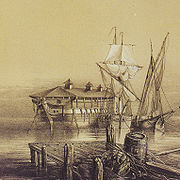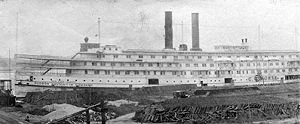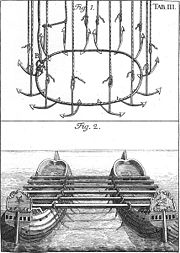
Hulk (ship)
Encyclopedia

Ship
Since the end of the age of sail a ship has been any large buoyant marine vessel. Ships are generally distinguished from boats based on size and cargo or passenger capacity. Ships are used on lakes, seas, and rivers for a variety of activities, such as the transport of people or goods, fishing,...
that is afloat, but incapable of going to sea. Although sometimes used to describe a ship that has been launched but not completed, the term most often refers to an old ship that has had its rigging
Rigging
Rigging is the apparatus through which the force of the wind is used to propel sailboats and sailing ships forward. This includes masts, yards, sails, and cordage.-Terms and classifications:...
or internal equipment removed, retaining only its flotational qualities. The word "hulk" is also used as a verb: a ship is "hulked" to convert it to a hulk.
Although the term "hulk" can be used to refer to an abandoned wreck or shell, it is much more commonly applied to hulls that are still performing a useful function. In the days of sail, many hulls served longer as hulks than they did as functional ships. Wooden ships were often hulked when the hull structure became too old and weak to withstand the stresses of sailing (i.e. their planking would admit too much water when moving in rough seas).
More recently, ships have been hulked when they become obsolete (e.g., when motorized ships replaced sailing ships) or when they become uneconomical to operate (e.g., some large oil tankers.)
Sheer hulk
A sheer hulk (or shear hulk), in the days of sailing shipSailing ship
The term sailing ship is now used to refer to any large wind-powered vessel. In technical terms, a ship was a sailing vessel with a specific rig of at least three masts, square rigged on all of them, making the sailing adjective redundant. In popular usage "ship" became associated with all large...
s, was used in shipbuilding and repair as a floating crane
Crane vessel
A crane vessel, crane ship or floating crane is a ship with a crane specialized in lifting heavy loads. The largest crane vessels are used for offshore construction. Conventional monohulls are used, but the largest crane vessels are often catamaran or semi-submersible types as they have increased...
, primarily to place the lower mast
Mast (sailing)
The mast of a sailing vessel is a tall, vertical, or near vertical, spar, or arrangement of spars, which supports the sails. Large ships have several masts, with the size and configuration depending on the style of ship...
s of a ship under construction or repair. The masts of the hulk (known as sheers
Sheers
Sheers are a form of two-legged lifting device, that were used by sailboats and dockyards for tasks such as lifting masts and heavier parts of the rigging on board....
) would be at an angle, and the ends could be effectively raised or lowered by rotating the hulk's hull, either by pulling on ropes attached to the hull, or by shifting the ballast
Sailing ballast
Ballast is used in sailboats to provide moment to resist the lateral forces on the sail. Insufficiently ballasted boats will tend to tip, or heel, excessively in high winds. Too much heel may result in the boat capsizing. If a sailing vessel should need to voyage without cargo then ballast of...
within the hull. The lower masts were the largest and most massive single timbers aboard a ship, and erecting these masts was extremely difficult without the assistance of either a sheer hulk or land-based masting sheer
Masting sheer
A masting sheer, sheers, shears or masting crane is a specialised shipyard crane, intended for placing tall masts onto large sailing ships...
.
Accommodation hulk
An accommodation hulk is a hulk used as housing, generally when there is a lack of quarters available ashore. An operational ship may be used for accommodation, but a hulk can accommodate more personnel than the same hull would accommodate as a functional ship. For this role, the hulk is often extensively modified to improve living conditions. Receiving hulks and prison hulks are specialized types of accommodation hulks. During World War II, purpose-built barracks shipBarracks ship
Barracks ship or barracks barge are terms used to indicate a ship or a non-self-propelled barge containing a superstructure of a type suitable for use as a temporary barracks for sailors. A barracks ship may also be used as a "Receiving Unit" for sailors who need temporary residence prior to being...
s were used in this role.
Receiving hulk

Ship
Since the end of the age of sail a ship has been any large buoyant marine vessel. Ships are generally distinguished from boats based on size and cargo or passenger capacity. Ships are used on lakes, seas, and rivers for a variety of activities, such as the transport of people or goods, fishing,...
that is used in harbor to house newly recruited sailor
Sailor
A sailor, mariner, or seaman is a person who navigates water-borne vessels or assists in their operation, maintenance, or service. The term can apply to professional mariners, military personnel, and recreational sailors as well as a plethora of other uses...
s before they are assigned to a crew.
In the Royal Navy
Royal Navy
The Royal Navy is the naval warfare service branch of the British Armed Forces. Founded in the 16th century, it is the oldest service branch and is known as the Senior Service...
, the use of impressment
Impressment
Impressment, colloquially, "the Press", was the act of taking men into a navy by force and without notice. It was used by the Royal Navy, beginning in 1664 and during the 18th and early 19th centuries, in wartime, as a means of crewing warships, although legal sanction for the practice goes back to...
to collect sailors resulted in the problem of preventing escape of the unwilling "recruits." The receiving ship was part of the solution; it was difficult to get off the ship without being detected, and in any case most sailors before the mid-19th century did not know how to swim.
Receiving ships were typically older vessels that could still be kept afloat, but were obsolete or no longer seaworthy. The practice was especially common in the age of wooden ships, since the old hulls would remain afloat for many years in relatively still waters after they had become too weak to withstand the rigors of the open ocean.
Receiving ships often served as floating hospitals as many were assigned in locations without shore-based station hospitals. Often the afloat surgeon would take up station on the receiving ship.
Prison hulk
A prison hulk was a hulk used as a floating prisonPrison ship
A prison ship, historically sometimes called a prison hulk, is a vessel used as a prison, often to hold convicts awaiting transportation to penal colonies. This practice was popular with the British government in the 18th and 19th centuries....
. They were used extensively in Great Britain
Great Britain
Great Britain or Britain is an island situated to the northwest of Continental Europe. It is the ninth largest island in the world, and the largest European island, as well as the largest of the British Isles...
, the Royal Navy
Royal Navy
The Royal Navy is the naval warfare service branch of the British Armed Forces. Founded in the 16th century, it is the oldest service branch and is known as the Senior Service...
producing a steady supply of ships too worn-out to use in combat, but still afloat. The harbour
Harbor
A harbor or harbour , or haven, is a place where ships, boats, and barges can seek shelter from stormy weather, or else are stored for future use. Harbors can be natural or artificial...
location of prison hulks was also convenient for the temporary holding of persons being transported
Penal transportation
Transportation or penal transportation is the deporting of convicted criminals to a penal colony. Examples include transportation by France to Devil's Island and by the UK to its colonies in the Americas, from the 1610s through the American Revolution in the 1770s, and then to Australia between...
to Australia
Australia
Australia , officially the Commonwealth of Australia, is a country in the Southern Hemisphere comprising the mainland of the Australian continent, the island of Tasmania, and numerous smaller islands in the Indian and Pacific Oceans. It is the world's sixth-largest country by total area...
and elsewhere overseas. These were decommissioned in the mid-19th century. A more recent example is HMP The Weare, which operated as a prison hulk in Portland, Dorset, from 1997 until 2009, to relieve overcrowding in the UK prison system.
Powder hulk
A powder hulk was a hulk used to store gunpowderGunpowder
Gunpowder, also known since in the late 19th century as black powder, was the first chemical explosive and the only one known until the mid 1800s. It is a mixture of sulfur, charcoal, and potassium nitrate - with the sulfur and charcoal acting as fuels, while the saltpeter works as an oxidizer...
. The hulk was a floating warehouse which could be moved as needed to simplify the transfer of gunpowder to warships.
Salvage pontoon

Floating storage and offloading units
Several of the largest former oil tankers were converted to Floating Production Storage and OffloadingFloating Production Storage and Offloading
A floating production, storage and offloading unit is a floating vessel used by the offshore industry for the processing of hydrocarbons and for storage of oil. A FPSO vessel is designed to receive hydrocarbons produced from nearby platforms or subsea template, process them, and store oil until it...
(FPSO) units, effectively very large floating oil storage tanks. The Knock Nevis
Knock Nevis
Seawise Giant, later Happy Giant, Jahre Viking, and Knock Nevis, was a ULCC supertanker and the longest ship ever built, and possessed the greatest deadweight tonnage ever recorded...
, by some measures the largest ship ever built, served in this capacity from 2004 until 2010.
Sailing ship hulks and coal hulks
Writing of the fate of the clipper shipsClipper
A clipper was a very fast sailing ship of the 19th century that had three or more masts and a square rig. They were generally narrow for their length, could carry limited bulk freight, small by later 19th century standards, and had a large total sail area...
, William L. Carothers said, "Clippers functioned well as barges; their fine ends made for little resistance when under tow ... The ultimate degradation awaited a barge. There was no way up, only down-- down to the category of coal hulks ... Having strong solid bottoms ... they could handle the great weight of bulk coal which filled their holds. It was a grimy, untidy, unglamorous end for any vessel which had seen the glory days."
The famed clipper Red Jacket
Red Jacket (clipper)
|-Further reading:-External links:* -Images and models:** by Percy A. Sandborne* Currier and Ives print* Currier and Ives print, with less color, Springfield Museum* ship model...
ended her days as a coaling hulk in the Cape Verde Islands.
When lumber schooner Johanna Smith
Johanna Smith (ship)
The Johanna Smith was a wooden-hulled schooner that transported lumber along the West Coast. She was built near North Bend, Oregon in 1917. She was sold to the Coos Bay Lumber company in 1918 and transported lumber until 1928....
, "one of only two Pacific Coast steam schooners to be powered by steam turbines,"
was hulked in 1928, she was moored off Long Beach, California and used as a gambling ship, until a fire of unknown cause finished her off.
One vessel rescued from this ignominious end was the barque Polly Woodside
Polly Woodside
Polly Woodside is a Belfast built, three-masted, iron-hulled barque, preserved in Melbourne, Australia and forming the central feature of the South Wharf precinct. The ship was originally built in Belfast by William J. Woodside and was launched in 1885...
, now a museum ship in Melbourne, Australia.
Another is the James Craig
James Craig (barque)
The James Craig is a three-masted, iron-hulled barque restored and sailed by the Sydney Maritime Museum.-History:Built in 1874 in Sunderland, England, by Bartram, Haswell, & Co., she was originally named Clan Macleod. She was employed carrying cargo around the world, and rounded Cape Horn 23 times...
rescued from Recherche Bay
Recherche Bay
Recherche Bay is located on the extreme south-eastern corner of Tasmania, Australia and was a landing place of the d’Entrecasteaux expedition to find missing explorer La Pérouse...
in Tasmania
Tasmania
Tasmania is an Australian island and state. It is south of the continent, separated by Bass Strait. The state includes the island of Tasmania—the 26th largest island in the world—and the surrounding islands. The state has a population of 507,626 , of whom almost half reside in the greater Hobart...
, now restored and regularly sailing from Sydney, Australia.

